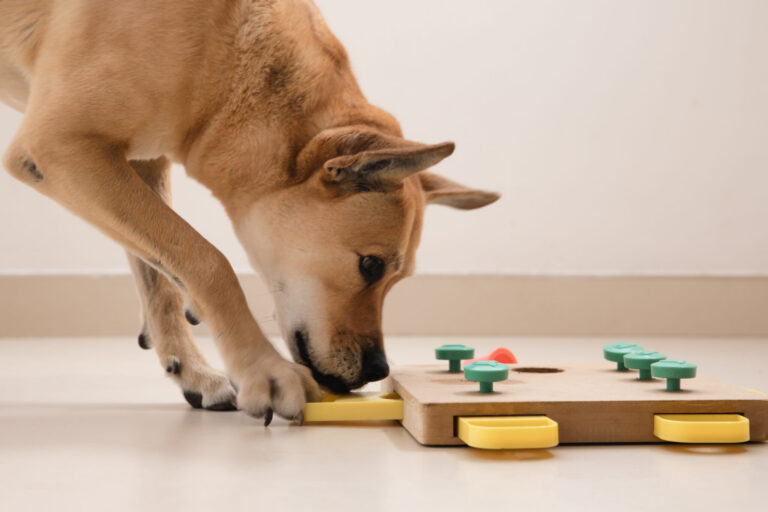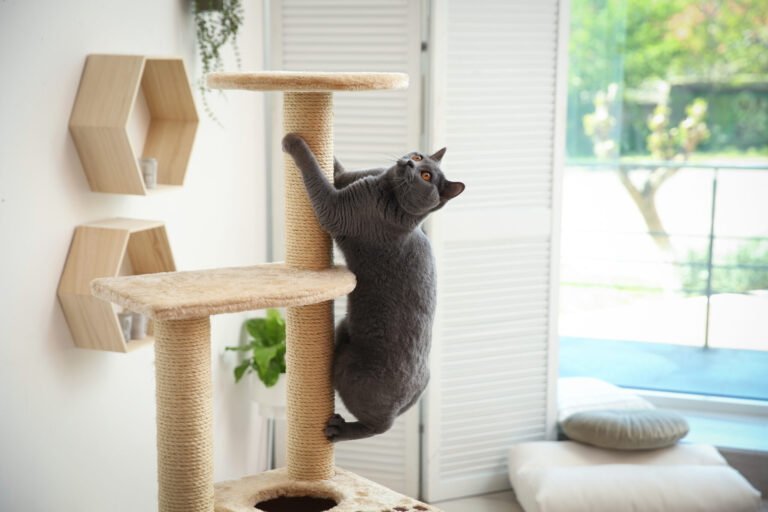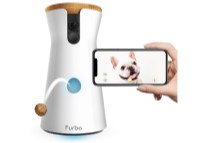Separation anxiety is becoming increasingly common in pets, especially if you’re like me and got your beloved furry friend in the pandemic when everyone was working from home. Now that people are back to work on a more frequent basis, our pets are left to fend for themselves—and some doing better than others.
7 ways to help your pet’s separation anxiety
SafeWise experts have years of firsthand experience testing the products we recommend. Learn how we test and review.
How to know if your pet has separation anxiety
Your pet might have separation anxiety if they exhibit the following behaviour:
- Signs of anxiety before you leave
- Excessive excitement upon your return
- Toileting inside
- Howling, barking/meowing and whining/crying
- Destructive behaviour
- Trembling and panting
- Circling and pacing while you’re away
- Vomiting or hairballs
A few things can cause separation anxiety in your fluffy family member. Pets with separation anxiety might have recently moved to a new home, welcomed a new baby into the family, had their owner(s) change their work schedule, or had a fellow pet or family member pass away.
Behaviourist and trainer, Lara Shannon, assures that mild cases of separation anxiety can be alleviated with independence training, enrichment, calming tools, and adequate exercise.
However, this isn't always enough. Symptoms related to separation anxiety are a result of distress and severe cases can elicit a response akin to a panic attack in humans.
You might need to discuss alternate options with your vet if the following strategies aren't helping to alleviate your pet’s anxiety.

Start with short absences
My partner and I adopted our puppy smack bang in the middle of the 2021 lockdown. We heard other puppy parents were struggling with kicking their pet’s separation anxiety after the the first lockdown came to an end.
As much as wanted to take our beloved boy everywhere with us, we knew it was important to leave him to his own devices sometimes. We started with short periods of time alone, just an hour or two while we got a coffee. Coupled with plenty of chew toys and a comfy bed, he began feel content in his own space.
If your pet is exhibiting signs of separation anxiety before you leave, try building up the time your pet spends alone. Start with short periods of time. A few minutes while you visit another room or take the rubbish out. Work your way up and leave them alone for 30 minutes to an hour. Get a coffee or go for a walk around the block. Leave your dog with a mentally enriching activity or toy, and cue them to their bed or their crate. With each session, gradually increase the time they are being left alone.
Upon returning home, calmly enter the door. They could still be chewing on their toy or treat. This helps to build a positive association with your departure and helps your pet to be content in your absence. If your pet starts getting overly excited, ignore the attention-seeking behaviour (we know, it's hard). Acknowledge their presence, but keep moving through the house and properly greet them once they’ve quietened down and have all four paws on the floor.
Create a mentally enriching environment
Enrichment provides your pet with an environment that stimulates their senses. It provides a safe space for your pet to display and express natural behaviours. For cats, this might look like scratching, chewing and chasing. For dogs, this might look like digging, hunting and sniffing. Giving your pet opportunities for enrichment helps keep them healthy, builds confidence, and reduces the potential for undesirable behaviours or symptoms associated with separation anxiety.
Enrichment needs might differ between cats and dogs. While dogs might be more drawn to activities that allow them to sniff out treats, cats might prefer a tower or ledge where they can watch the birds outside.
Be careful when letting your cat near open windows when you’re not home, as they might jump out, especially if they see wildlife down below. Keep the window locked and closed if possible.

Types of enrichment
We recommend trying different types of enrichment activities to see what your pet best responds to. Each category stimulates different senses and ensures your dog doesn't get bored.
- Social – socialising with other pets or humans. When cats sit on the edge of the windowsill and watch the wildlife go by.
- Sensory – stimulates multiple senses. Toys that allow for your dog to squeak and chew, or a walk where they can smell, hear, and feel the grass beneath their paws.
- Cognitive – exposure to new experiences, smells, solving puzzles, or teaching your pet a new trick.
- Physical – physical activity like playing with toys (scratching posts and climbing shelves for cats), other pets, and going on walks.
- Nutritional – emphasises your pet working for their food, and makes it more exciting for them. Try a puzzle feeder or snuffle mat.
Here are some of our favourite ways to keep our pets enriched and entertained!
- Filling a KONG (with peanut butter, lactose-free yoghurt, frozen mince, or whatever your pooch likes!)
- Long-lasting dental chews
- Scattering their breakfast on a snuffle mat or puzzle feeder before leaving for work
- Setting up a scavenger hunt with their favourite treats hidden around the yard and home
- Treat dispensing toys
- Cat trees
- Vertical scratching post
Make sure your pet is getting enough playtime or exercise
Exercise and playtime are essential for both dogs and cats. The amount of exercise needed for your pet is dependent on your pet’s breed and energy levels. Puppies especially will benefit from longer playtime sessions so they can release their pent-up energy in a healthy way. 20 minutes of enrichment time throughout the day in addition to a daily walk is usually good for most dogs.
An animal tired from healthy mental and physical stimulation is significantly less likely to destroy things. Pets that get bored or don’t get enough playtime can form dysfunctional bonds with their owners and develop unhealthy habits.

Minimise disturbances
If your pet stays inside while you’re away or at work, try closing the curtains or blinds to reduce what your pet can see, especially if they’re barking or howling excessively. If they’re dwelling in the living room while you’re out, try putting on the radio to muffle any outside sounds, or put on one of the many ‘Dog TV’ videos on YouTube.
Create a safe haven
A safe haven is an area your pet goes to when they feel tired, anxious, or scared – this place is made for them to feel safe. It gives them security, reduces their anxiety, and should be a place they can go to get away from other family members (furry and human).
This space should be quiet and easily accessible, so they can retreat to their safe spot when feeling anxious or unwilling to be around others and exit when they feel comfortable.
Ideally, you should teach your pet to go to their safe haven as early on in their life as possible. It should be big enough for them to stretch out their whole body and relax and should have food, water, treats, and blankets. We recommend a large crate or play pen.
The first introduction to their safe haven should be when they need rest – ideally after a period of play or exercise. Leave the door open, and prompt them to rest amongst their toys and in their bed with the door open. If they don't fall asleep, simply reward any behaviour where they investigate the area, or if they sit down chewing quietly. This is what you want – an area where your dog feels comfortable enough to sleep, relax, and chew on a bone or toy.
The safe haven can alleviate anxiety and can help your pet de-stress. It's easy for pets to get overwhelmed, especially if there are too many people, other pets, or loud noises. Having a space they can retreat to if feeling overstimulated is greatly beneficial.
Address departure cues
Does your pet know you’re going somewhere as soon as you pick up the keys, or start putting your shoes on? Pets can quickly pick up what cues signal your departure. Cues might differ from pet to pet – you know which cue your pet responds strongest to. For some, it might be grabbing their lunchbox from the fridge, and for others, it might be brushing their teeth.
We recommend changing up your routine slightly so you can normalise the cues and dissociate them with leaving. Pick up your keys, but put them back down. Put your shoes on and continue the household routine without leaving just yet. Alternatively, you can perform the cue out of your pet’s sight so their anxiety doesn't heighten.
See what they're up to with a pet camera
Pet cameras keep a watchful eye on your fur babies to help make that time away less painful. One of the biggest benefits is the peace of mind you get knowing your animal is okay when home alone and not getting into mischief!
We think the Furbo Dog Camera is a fantastic option for checking up your dog when they're home alone. It also sends alerts when your dog is barking or howling, and allows you to dispense treats to them through the app. This is a solid option if you have a dog that tends to bark or howl excessively to cope with it's separation anxiety.
Consider medication
If your pet’s separation anxiety is so severe none of the above tips have helped, it may be worth contacting your veterinarian to survey your options – one of which may be medication. Typically a last resort, medication can help calm your pet if they are posing a danger to themselves or other pets.
